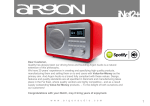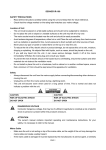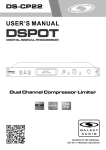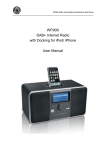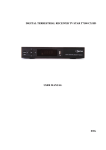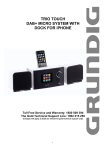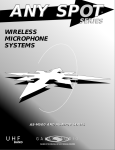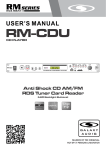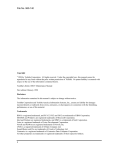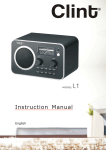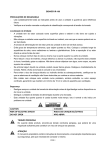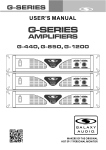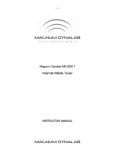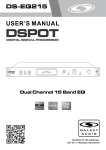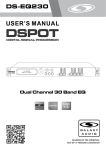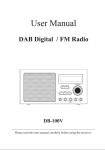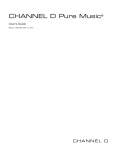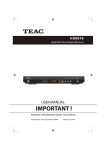Download rm-ird manual - Galaxy Audio
Transcript
USER’S MANUAL MAIN VOLUME MODE PREV PLAY/PAUSE LED NEXT MENU STAND BY PRESET ALARM SLEEP MUTE INFO BACK ON/OFF ZZ Z REPEAT SHUFFLE AUX IN POWER 19" (482mm) CONTROL SELECT Contents Introduction............................................................................................................... 1 Safety Instructions.................................................................................................... 2 1.Overview................................................................................................................. 3 2. Controls and Interface...................................................................................... 4 - 8 3. Getting Started................................................................................................ 9 - 16 3.1 Setup and Common Settings...................................................................................... 9 - 13 3.2 Internet Radio Portal Registration............................................................................. 13 - 14 3.3 Setting up a Music Server............................................................................................... 14 3.4 Sharing and Streaming Media.................................................................................. 15 - 16 4. Internet Radio Mode...................................................................................... 17 - 19 4.1 Last Listened, Presets, and Favorites....................................................................... 17 - 18 4.2 Browsing and Searching........................................................................................... 18 - 19 4.3 My Added Stations and Now Playing............................................................................... 19 5. Music Player Mode (Network and USB)......................................................... 20 - 22 5.1 Shared Media (from UPnp media server).................................................................. 20 - 21 5.2 USB playback.......................................................................................................... 21 - 22 5.3 Playlists and Now Playing............................................................................................... 22 6. Using the “Play To” Feature in Windows 7 to Stream Media........................ 23 - 24 6.1 Use “Play To” in Windows Media Player........................................................................... 23 6.2 Use “Play To” Elsewhere in Windows 7............................................................................ 24 6.3 Now Playing Information................................................................................................. 24 7. DAB................................................................................................................ 24 - 26 7.1 Scanning for Stations, Selecting Stations, and Now Playing Information........................... 25 7.2 Settings.......................................................................................................................... 26 8. FM Radio Mode.............................................................................................. 26 - 27 9. AUX in Mode......................................................................................................... 27 10. Alarms and Sleep............................................................................................... 28 11. Factory Reset..................................................................................................... 29 12. Map of Modes and Menus................................................................................... 29 13. Specifications.................................................................................................... 30 Introduction Thank you for choosing a Galaxy DSPOT Digital Signal Processor. You have joined hundreds of thousands of other satisfied Galaxy customers. Since 1977 Galaxy Audio’s professional experience in design and manufacturing ensure our products' quality, performance and reliability. For the most up to date manual and information visit www.galaxyaudio.com. 1 Safety Instructions This symbol indicates that there are important Operating and maintenance instructions in the Literature Accompanying This Unit This symbol indicates that dangerous voltage Constituting a risk of electric shock is present within this unit. ! IMPORTANT SAFETY INSTRUCTIONS ! 1. 2. 3. 4. 5. 6. 7. READ these instructions. KEEP these instructions. HEED all warnings. FOLLOW all instructions. DO NOT use this apparatus near water. CLEAN ONLY with dry cloth. DO NOT block any ventilation openings. Install in accordance with the manufacturer's instructions. 8. DO NOT install near any heat sources such as radiators, heat registers, stoves, or other apparatus (including amplifiers) that produce heat. 9. DO NOT defeat the safety purpose of the polarized or grounding-type plug. A polarized plug has two blades with one wider than the other. A grounding type plug has two blades and a third grounding prong. The wider blade or the third prong are provided for your safety. If the provided plug does not fit into your outlet, consult an electrician for replacement of the obsolete outlet. 10. PROTECT the power cord from being walked on or pinched, particularly at plugs, convenience receptacles, and the point where they exit from the apparatus. 11. ONLY USE attachments/accessories specified by the manufacturer. 12. USE only with a cart, stand, tripod, bracket, or table Specified by the manufacturer, or sold with the Apparatus. When a cart is used, use caution when moving the cart/apparatus combination to avoid injury from tip-over. 13. UNPLUG this apparatus during lightning storms or when unused for long periods of time. 14. REFER all servicing to qualified service personnel. Servicing is required when the apparatus has been damaged in any way, such as power-supply cord or plug is damAged, liquid has been spilled or objects have fallen into the apparatus, the apparatus has been exposed to rain or moisture, does not operate normally, or has been dropped. 15. DO NOT expose the apparatus to dripping and splashing. DO NOT put objects filled with liquids, such as vases, on the apparatus. 16. Remove the batteries from the receiver if the system will not be used for a long period of time. This will avoid any damage resulting from a defective, leaking battery. 17. DO NOT throw used batteries into a fire. Be sure to dispose of or recycle used batteries in accordance with local waste disposal laws. 2 Overview 1. Overview MAIN VOLUME MODE PREV PLAY/PAUSE LED NEXT MENU STAND BY PRESET ALARM SLEEP MUTE INFO BACK CONTROL SELECT ON/OFF ZZ Z REPEAT SHUFFLE AUX IN POWER Included Accessories: l l l l l FM Antenna Wire AC Power Cord AV Wire 2.4G Antenna Remote Controller x1 x1 x1 x1 x1 External Resources: To operate unit, following external resources are needed: l l l l l A power source (AC 110 V mains supply) A wired (Ethernet) or wireless (Wi-Fi) network (provided through a router) with appropriate permissions and password if necessary (for Internet radio and Network Music player modes) Broadband Internet access for Internet radio mode. A music library stored on the network or on a USB mass storage device (for Music player modes), An external audio source (for Aux in mode) Connectors l l l l l Ethernet- RJ45 Audio out- RCA x 2 Line in- 3.5mm TRS Headphones out- 3.5mm TRS USB- Type A Features l l l l l l l l l l l Internet Radio with access to over 20,000 stations, ‘Listen again’ broadcasts and podcasts Music player allowing easy navigation and playback through a USB or network-stored library of music les including AAC/AAC+, MP3, WMA, WAV “Play To” feature allowing media to be pushed from a PC running Windows 7 to the unit operating in Digital Media Renderer (DMR) mode DAB/DAB+ digital radio with a wide choice of channels and digital quality sound broadcast FM with RDS (Radio Data System) Aux in for external music sources such as MP3 players Large 2.7 inch display for easy control and clear information display, with up to six lines of text plus status icons Infrared remote control Clock with auto-update capability and dual independent alarms Sleep/snooze Multiple network proles for easy setup 3 Interface, Controls, and Display 2. Interface, Controls, and Display Main Controls Button Control Select Function Turn to scroll through a menu of station list. The chosen option is highlighted in reverse text (dark characters on a white background) Press to select. Button LED ON/OFF STANDBY Function Press to turn on/off for LED backlight. Turn on or back to standby mode (showing clock and date). Cancels sleep function. SLEEP Sleep/snooze: When playing, standby after a set time. When alarm is sounding, snooze for a set time. ALARM Enters alarm wizard, turns off alarm (when alarm is sounding) and toggles between alarms in standby. MENU Menu: Show menu for the current mode. Press again to show Now playing screen. MODE Cycle through the modes: Internet Radio, Music player, DAB, FM, Aux in MUTE Mute audio output. MAIN VOLUME Increase or decrease volume level. PRESET Press for the Preset recall/Save menu; Scroll up/down to select the preset number then press 'Select' to conrm. There are 10 presets each for Internet radio, DAB and FM INFO View more information about the station or track playing. Press again to cycle through further information screens then return to the normal Now playing screen. Previous : Select start of track, previous track or hold to scan down rewind. Next : Select next track or hold to scan up/fast forward. Play / Pause / Stop REPEAT Music player repeat songs. SHUFFLE Music player shufe songs. 4 Remote Control Remote Control The remote control operates in a similar way to the main keypad. INTERNET RADIO 1 2 3 PRESET 4 5 SHIFT SLEEP INFO ALARM MENU ENTER MODE REPEAT PLAY/STOP SHUFFLE VOLUME MUTE / Button Function Standby: Turn on or back to standby mode (showing clock and date). Cancel sleep function. SLEEP Sleep/Snooze: When playing, standby after a set time. When alarm is sounding, snooze for a set time. ALARM Enters alarm wizard, turns off alarm (when alarm is sounding) and toggles between alarms in standby. MODE Cycle through the modes: Internet Radio, Music player, DAB, FM, Aux in. 1 Set/recall preset 1 or 6. 2 Set/recall preset 2 or 7. 3 Set/recall preset 3 or 8. PRESET Press for the Preset recall/Save menu; Scroll up/down to select the preset number then press ‘Select’ to conrm. There are 10 presets each for Internet Radio, DAB and FM. 4 Set/recall preset 4 or 9. 5 Set/recall preset 5 or 10. 5 SHIFT Press Shift then Preset to access higher preset numbers. MENU Menu: Show menu for the current mode. Press again to show Now Playing screen. INFO View more information about the station or track playing. Press again to cycle through further information screens then return to the normal Now Playing screen. REPEAT Music player repeat songs. SHUFFLE Music player shufe songs. Up: Scroll up through a menu or station list. Back Down: Scroll down through a menu or station list. Forward / Play / Pause / Stop Decrease Volume Increase Volume Mute Audio Output Previous: Skip back to previous track. Rewind Fast Forward Next: Skip forward to next track. 6 Screens The screen shows various menus, dialogues and displays, as described below. There are basically six types of screen: l l l l l l Standby (Clock) Splash (Mode) Now Playing Dialogue Error/Information Menu When text is too long to t on the screen, it is rst shown truncated, then, after a few seconds, slowly scrolls so that you can read it all. The Standby Screen shows the time, date and any active alarm times. As you cycle through the play modes using Mode , the unit shows a Splash Screen for each mode. After one second, the unit enters the selected mode and tries to start playing the last station or track that was playing in that mode. If this is not possible, the unit tries to connect to the selected source by scanning for stations, networks, or prompting for user input as appropriate. Now Playing Screens show information about the audio source and track now playing, where available. Dialogue Screens are shown to allow the user to change settings. They vary in complexity from simple Yes/No options up to the scrollable network password input screen. As with menus, the selected item is shown with a white background. Dialogue screens mark the current setting with an asterisk (*). 7 Error/Information Screens give specic messages for a few seconds, then change automatically to another screen. Menus The unit has basically three types of menu. Use the Select control to step through and select options. A scroll bar on the right of the screen shows if there are further options above or below those visible. Each mode has a Mode Menu, with options specic to that mode. For example, the FM mode menu has just two options: Scan setting and Audio setting. In addition, each mode menu has two nal options: System settings > and Main menu >. The ‘>’ indicates options leading to further menus. The System settings Menu allows access to system settings and information such as network, time, language and software update. Menus with more options than will t on one screen have a scroll bar to the right. The Main menu allows access to all modes plus sleep and timer functions. Some menus, for example the System settings menu, have several submenus. A menu map of the unit is shown in Chapter 12 of this manual. 8 Getting Started 3. Getting Started 3.1 Setup and Common Settings To set up the unit: 1. 2. 3. 4. Place the unit on a suitable shelf or table Connect the power adaptor between the unit and the mains supply. Attach the WiFi antenna To receive broadcast radio (DAB and FM), attach the wire antenna. The setup wizard will now start. Setup Wizard WELCOME When the unit is started for the rst time, it runs through a setup wizard to congure settings for date/time and network. Once this has nished, the system is ready to use in most modes. Note: To change these settings later, select Menu > System settings >. To run the setup wizard again, select Menu > System settings > Setup wizard. Select Yes to start the setup wizard. If you choose No, the next screen asks if you would like to run the wizard next time the unit is started. The system then starts without conguring time/date and network settings and enters the Main Menu. Note: If power is removed while the wizard is in progress, the wizard will run again next time when the unit is started. 12/24 Hour Display To change between 12 and 24 hour display, select Set 12/24 hour and then select your preference. Time/Date The time and date can be updated manually or automatically. With auto-update, the time and date are automatically synchronized with external clocks. Auto-update is generally more accurate. 9 Auto-Update Auto-update works with data sent over DAB, FM or the Internet. The clock is only updated when in a corresponding mode, so it is best to select a mode you use regularly. DAB and FM use time signals broadcast with radio transmissions. Network uses a time signal sent from the Frontier Silicon Internet radio portal when in any network- connected mode. 1. Select Update from DAB, Update from FM, Update from Network or No update. 2. If you are updating from the network, set your time zone. 3. If your country uses daylight saving, the automatically updated time from the network may be wrong by one hour. When daylight savings are in effect (during the winter), turn on the Daylight savings option to rectify this. Note that if you are updating the time from DAB or FM, the Daylight savings option has no effect on the clock’s time. The unit will auto-update from the selected source when time information is available. Manual set If you set No update, the wizard now prompts you to set the time and date manually. The date and time are displayed as dd-mm-yyyy and hh:mm AM/PM with the rst value, dd, active (ashing). Adjust each value with the Select control. As each value is set, the next value becomes active and ashes. Network The unit is compatible with all common network protocols and encryption methods, including Wi-Fi Protected Setup (WPS) To connect the unit to your network, you need one of the following: Ÿ A wired router and an Ethernet (RJ45 network) cable Ÿ A Wi-Fi wireless router, together with password key if set Select WLAN region/country > Wi-Fi network (SSID), and then select a network from the list. To connect to a wired network, select [Wired], after ensuring that the Ethernet cable from the wired router is connected to the Ethernet socket of the unit. If the network is open (non-encrypted), the unit connects without any further ado; see following page. 10 Standard encrypted network To enter the network’s key (password), use the Select control to move the cursor through the characters and select. As each character is selected, the key is built up near the top of the display. There are three options accessible by turning Select back before the rst characters (0123…) – Backspace, OK and Cancel. WPS encrypted network WPS encrypted networks are identied by ‘[WPS]’ at the start of the network name, and have three methods of connection. Select one and follow the prompts: l Push Button > The unit prompts you to press the connect button on the router. It then scans for a ready Push Button Connect network and connects. l Pin > (code number) The unit generates an 8-digit code number which you enter into the wireless router, access point, or an external registrar (e.g. advanced versions of Windows Vista). l Skip WPS > Enter key as for a standard encrypted network, above. For more information on setting up a WPS encrypted network, see your WPS router’s instructions. 11 Completion The unit tries to connect to the selected network. If connecting fails, the unit returns to a previous screen to try again. If the network connection is lost, the unit automatically tries to reconnect. Common settings Equaliser Several preset EQ modes are available; also a user-dened setting. To adjust the EQ, select Menu > System settings > Equaliser. You can then choose from a variety of preset modes or create your own, with custom bass, treble and loudness settings. 12 Network The unit remembers the last four wireless networks it has connected to, and automatically tries to connect to whichever one of them it can nd. You can see the list of registered networks through Menu > System settings > Network > Network prole >. From here you can delete unwanted networks by turning and pressing Select then conrming delete Yes. There are also other options for viewing and manually altering network settings from Menu > System settings > Network > (for example setting up a wired network). Users experienced with networking may nd these options useful for diagnosing and xing network problems. Language The default language is English. To change, select Menu > System settings > Language > then select your language. (Language selection: English / German / Italian / French / Spanish) 3.2 Internet Radio Portal Registration The Frontier Silicon Internet radio portal website allows you to organize your favorites lists and also listen to Internet radio on a computer. 13 To register your unit with the portal, switch to Internet radio mode, and then obtain your radio's unique portal access code by selecting Menu > Station list > Help > Get access code >. Write down the access code. Note: Do not confuse the portal access code with the Radio ID (from Menu > System settings > Info.) Visit the portal website at, www.wiradio-frontier.com If this is your rst visit to the portal, register for a new account, entering the following information: l l l l Access code, Your e-mail address, Password, Radio model (Jupiter 6.2). If you already have an account and wish to add an additional radio, log in to your account and select My preferences > Add another Wi-Fi radio. Once your radio is registered with the portal, you can immediately use the Internet radio favorites and added stations features. 3.3 Setting up a Music Server In order for the unit to play music les from a computer, the computer must be set up to share les or media. UPnP media sharing allows devices to play music from a shared media library, navigating through tag menus such as Artist, Album or Genre. If you are running a suitable server system such as a PC with Windows Media Player 10 or later (WMP), and your music library is well-tagged, then it is recommended to use media sharing. Only the UPnP server needs to be set up. 14 3.4 Sharing and Streaming Media Sharing Media with Windows Media Player The most common UPnP server is Windows Media Player (10 or later). Alternatively, other UPnP platforms and servers may be used. To set up WMP for media sharing, perform the following steps: 1. Ensure that the PC is connected to the network. 2. Ensure that the radio is powered on and connected to the same network. 3. In WMP, add to the media library the audio les and folders you want to share with the unit (Library > Add to Library…). 4. In WMP, enable media sharing (Library > Media sharing…). Make sure that the radio has access to the shared media by selecting it and clicking Allow. You can also set a name for the shared media in Settings… Click OK to close the dialogue boxes. The PC is now ready to stream the music to the radio. The WMP UPnP service runs in the background; there is no need to start WMP explicitly. 15 Setting the Unit up for “Play To” Windows 7 Streaming Media Feature. To set-up the unit to be controlled and to stream music via Windows Media Player 12 (Windows 7 only), perform the following steps: 1. Ensure that the PC is connected to the network. 2. Ensure that the unit is powered on and connected to the same network. Note: the unit must be in an Internet radio mode to be detected. 3. From the Windows 7 main screen, select Start > Devices and Printers. 4. Select the Add a device tab in the top left of the Devices and Printers window and follow the instruction prompts given by the wizard. In the Devices and Printers window a Jupiter 6 icon will appear and you are now ready to stream your Windows media music les to the unit. 16 Internet Radio Mode 4. Internet Radio Mode 4.1 Last Listened, Presets, and Favorites The unit can play thousands of radio stations and podcasts from around the world though a broadband Internet connection. When you select Internet radio mode, the unit contacts the Frontier Silicon Internet radio portal to get a list of stations, organized into different categories like Country, Most popular and Genre. Once you select a station, the unit connects directly to that station. The portal also enables multiple lists of favorite stations that you can personalize, for example Andy's stations, Joe's favorites, Talk shows. To use the favorites feature, register your radio with the portal website. If you have several Frontier Silicon radios, you can register them all on the same account so that each radio has access to your favorites lists. It is possible to add favorites either directly through the unit or through any computer with a web browser. To enter Internet Radio mode, either press Mode until the display shows Internet Radio or select Menu > Main menu > Internet Radio. Note: The station list menu is provided from the Internet radio portal, so it is only accessible when the unit is connected to the Internet. Station lists and submenus may change from time to time. There are several ways of selecting stations. Directly from the radio: l l Last Listened Presets From the portal through the Menu > Station list > menu: l l l l Favorites Lists Browse by Country, Genre, Most popular, Newest Search by Keyword My Added Stations If you are already listening to an Internet radio station, you can press Back rather than Menu too quickly return to the last visited branch of the menu tree. For example, suppose you were listening to New Orleans Radio through the browse facility. Pressing Back would return you to the Highlighted Blues stations menu. Pressing Back again would return you to the Blues menu, and so on. 17 Last Listened When Internet radio mode restarts, the last-listened station is selected. To select another recently used station, select Menu > Last listened then one of the stations listed. Most recent stations appear at the top of the list. Presets Presets are stored in the radio and cannot be accessed from other radios. To store an Internet radio preset, press and hold Preset until the display shows the Save preset screen. Select one of the 10 presets to save the currently playing station. To select a preset, press Preset briey, then select one of the listed preset stations. When a preset station is playing, it shows Pn (P1, P2 etc) in the bottom of the screen. Note: Operation of presets is identical for Internet radio, DAB and FM. Favorites Favorites are stored on the Internet radio portal. Before you set up an account on the portal from its Web interface (www.wiradio-frontier.com), the favorites are associated solely with the radio on which you set them. After you set up a portal account, all the favorites from your different radios are merged into a combined favorites list. This combined list is available to all the radios on your account. To store a playing station as a favorite, press and hold Select until the display shows ‘Favorite added’. The station appears in the default favorites list Stations. To select a favorite, select Menu > Station list > My favorites > [Favorites list] > [Station]. 4.2 Browsing and Searching Browsing To browse Internet broadcasts, select Menu > Station list > then either Stations > or Podcasts >. Browse through the menus to nd broadcasts. Note: BBC radio ‘Listen Again’ programs are accessible through the Podcast menu, for example Menu > Podcasts > Location > Europe > United Kingdom > All shows > BBC Radio 4 > You and Yours > 20/10/2008 - October 20. 18 Searching You can also search through Internet broadcasts for stations or podcasts with particular keywords in their title. To search, select Menu > Station list > then either Stations > or Podcasts >. Enter a keyword by selecting characters then OK. The search entry screens are similar in operation to the Wi-Fi password entry screen. Select a broadcast from the list. For podcasts, you may be able to select a particular episode. 4.3 My Added Stations and Now Playing My Added Stations Even though the Internet radio portal contains thousands of stations, you may want to listen to stations not listed. You can add your own stations via the portal. These added stations are accessible from the unit by selecting Menu > Station list > My added stations > [Station]. Now Playing Information While the stream is playing, the screen shows its name and description. If artist and track information is available, this is also shown. To view further information, press Info . Each time you press Info , another set of information is displayed, cycling through the following details: l l l l l l l Artist and track name (default; where available) Station description Station genre and location Signal reliability Codec and sampling rate Playback buffer Today’s Date 19 Music Player Mode (Network and USB) 5. Music Player Mode (Network and USB) Music player mode plays audio les such as MP3s, AACs, WMAs or FLACs from a computer on the local network, or from a USB Flash stick or a hard drive. To enter Music player mode, either press Mode until the display shows Music player, or select Menu > Main menu > Music player. Once in music player mode, press Menu , then select either Shared media or USB playback. If you are already playing a music le, you can press Back rather than Menu to quickly return to the last visited branch of the menu tree. For example, suppose you were listening to the track Heat by the artist 50 Cent through browsing shared media. Pressing Back would return you to the track listing for the album Get Rich or Die Tryin'. Pressing Back again would list all 50 Cent albums. Pressing Back again would list all album artists, and so on. You can use << and >> to move through tracks. Press and hold to rewind or fast forward and press quickly to select previous or next track. 5.1 Shared Media (from UPnP media server) Select Menu > Shared media > If you have set up shared media, you should see an entry consisting of <computer name>: <Shared media name>, for example JB-Laptop: Audio. If you have more than one computer sharing media, the alternatives are listed. Select the shared media you want to play. From this point on, the menus are generated from the shared media server (typically Windows Media Player). The rst menu shows a list of media types, for example Music, Video, Pictures and Playlists. The unit can only play music and playlists. 20 From Music, there are numerous ways of selecting tracks, including: l l l l l Genre Artist Album Composer Rating Once you have found a track you want to play, press Select . A short press plays the track immediately and a long press adds the track to the playlist. You can also add entire albums to the playlist. The unit plays either the selected track or the playlist. Wake-on-LAN If shared media is selected a list of available music servers will be displayed. If a question mark appears before the server name, this indicates that the server has been seen before and supports Wake-on-LAN functionality, but cannot currently be found on the network. If a server with a question mark is selected by the user, the device will try to wake the server up and connect to it. In some instances this may not be possible as the server may not be connected to the network any more or may be switched off. Prune servers From time to time it may be necessary to remove servers displaying question marks in front of the server name from the server list. For example, if the device is moved to a new network or if a Wake-on-LAN server is removed from your current network. To perform this function go to Menu > Prune servers > Yes 5.2 USB playback To play audio from a USB mass-storage device such as a USB Flash stick or USB hard drive, Select Menu > USB playback. Browsing folders From this point on, menus are generated from the folders on the USB device. Browse folders with the Select control and Back button. The display shows folder and le names (not necessarily track names). 21 Once you have found a track that you want to play, press Select . A short press plays the track immediately and a long press adds the track to the playlist. You can also add entire folders to the playlist. The unit plays either the selected track or the playlist. Viewing Track Metadata While a track is playing, you can view extra information about it (metadata) by pressing Info . Each time you press Info , a different item of metadata is displayed. 5.3 Playlists and Now Playing The unit holds a queue of up to 500 tracks in the playlist. Playlist tracks can be mixed from multiple UPnP servers and USB. To manage the playlist, select Menu > My playlist. l l l To view the playlist, scroll though it by turning Select . UPnP tracks show their track name; USB tracks show their le name. To play the playlist from a certain track, quick Select . To erase a track from the playlist, long Select . then conrm YES If you select a track/album/folder for instant playback (without using the playlist), the playlist is preserved. The playlist is also preserved during standby. Repeat/shufe You can repeat tracks or play them in random order by selecting Menu > Repeat play > or Menu > Shufe play. Now playing information While a track is playing, the screen shows its track and artist (UPnP) or le name (USB). There is also a progress bar with gures for elapsed and total track time. At the bottom of the screen, an icon indicates UPnP or USB depending on the source. To view further information, press Info . Each time you press Info , another set of information is displayed, cycling through: l l UPnP: playback progress bar (default), album, codec/sampling rate, playback buffer bar, today's date USB: playback progress bar (default), artist, album, folder, full le path, bit rate/codec type/sampling rate, playback buffer bar, today's date 22 Using the “Play To” Feature in Windows 7 to Stream Media 6. Using the “Play To” Feature in Windows 7 to Stream Media One of the new Windows 7 features includes a feature called “Play To” and this lets your PC running Windows 7 control the unit to push media and use as a universal remote control for your media collection. Jupiter 6.2 supports the industry standard DLNA (Digital Living Network Alliance) 1.5 digital media render. This allows you to "Play To" other devices around your home and combine media streaming with controlling a connected media receiver while streaming content to it from another Windows 7 PC on a home network. Before you can use the “Play To” feature you need the set-up Jupiter 6.2 for Windows 7 streaming media. 6.1 Use “Play To” in Windows Media Player Windows Media Player makes it easy to manage your media, nd items that you want to play, and open Play To. To select items that you want to play, follow these steps: 1. Click the Start button, click All Programs, and then click Windows Media Player. If the Player is currently open and you're in Now Playing mode, click the Switch to Library button in the upper-right corner of the Player. 2. If the list pane is closed or if the Burn or Sync tabs are exposed, click the Play tab. 3. Find the items that you want to play in the Player Library, and then drag those items from the details pane into the list pane. 4. Click the Play to button at the top of the list pane, click the device on your network that will receive the media. 5. In the Play To dialog box, use the playback controls to play, pause, or stop the media stream, and to change to the next or previous item in the list. 23 DAB Radio Mode 6.2 Use “Play To” Elsewhere in Windows 7 Outside of Windows Media Player, you can stream media to the unit with “Play To” by right-clicking music les. To select music les and stream them to the unit, follow these steps: 1. Click the les you want to stream to the unit. 2. Right-click the selected les, point to “Play to”, and then click the device on the network that will receive the media. 3. In the Play To dialog box, use the playback controls to play, pause 6.3 Now playing information While a track is playing, the screen shows its track name (UPnP). There is also a progress bar with gures for elapsed and total track time. At the bottom of the screen, an icon indicates UPnP. To view further information, press Info . Each time you press Info , another set of information is displayed, cycling through the following: l l l l Artist, Album, Codec/Sampling Rate, Playback Buffer 7. DAB Radio Mode DAB radio mode receives DAB/DAB+ digital radio and displays information about the station, stream and track playing. To enter DAB mode, either press Mode until the display shows DAB Radio or select Menu > Main menu > DAB. 24 7.1 Scanning for Stations, Selecting Stations and Now Playing Information Scanning for Stations The rst time you select DAB radio mode, or if the station list is empty, the unit automatically performs a full scan to see what stations are available. You may also need to start a scan manually to update the list of stations for one of the following reasons: l l l Available stations change from time to time. If reception was not good for the original scan (for example the antenna was not up), this may result in an empty or incomplete list of available stations. If you have poor reception of some stations (burbling), you may wish to list only stations with good signal strength. To start a scan manually, select Menu > Scan. Once the scan is complete, the radio shows a list of available stations. To remove stations that are listed but unavailable, select Menu > Prune invalid. Selecting Stations To listen to or change a station, turn the Select control to view a list of stations and press to select. Once selected, the station plays and the screen shows information about the station, track or show as broadcast. Presets To store a DAB preset, press and hold Preset until the display shows the Save preset screen. Select one of the 10 presets to save the currently playing station. To select a preset, press Preset briey, then select one of the listed preset stations. When a preset station is playing, it shows Pn (P1, P2 etc) in the bottom right of the screen. Now Playing Information While the stream is playing, the screen shows its name and DLS (Dynamic Label Segment) information broadcast by the station giving real-time information such as program name, track title and contact details. Stereo broadcasts are indicated with an icon at the top of the screen. To view further information, press Info . Each time you press Info , another set of information is displayed, cycling through DLS text, program type, ensemble name/frequency, signal strength/error rate, bit rate/codec/channels and today's date. 25 FM Radio Mode 7.2 Settings Dynamic Range Compression Some DAB broadcasts offer dynamic range compression (DRC). This feature allows radios to compress the dynamic range of the output audio stream, so that the volume of quiet sounds is increased, and the volume of loud sounds is reduced. This can be useful if you are listening to music with a high dynamic range in a noisy environment (for example, classical music while cooking). To change the DRC of the unit, select Menu > DRC, and then DRC high, DRC low or DRC off. Note: The unit DRC setting does have any effect if DRC data is not included in the broadcast. Station Order You can choose the order of the DAB station list to be Alphanumeric, Ensemble or Valid. Ensemble lists groups of stations that are broadcast together on the same ensemble, for example BBC or South Wales local. Valid lists valid stations rst, alphanumerically, then off-air stations. To change station order, select Menu > Station order > then Alphanumeric, Ensemble or Valid. 8. FM Radio Mode FM radio mode receives analog radio from the FM band and displays RDS (Radio Data System) information about the station and show (where broadcast). To enter FM mode, either press Mode until the display shows FM Radio or select Menu > Main menu > FM. Selecting Stations To nd a station, press Select . The frequency display starts to run up as the unit scans the FM band. Alternatively, you can scan up or down by pressing and holding the >> or << buttons or tune manually with quick presses, or by turning the Select control. Presets To store an FM preset, press and hold Preset until the display shows the Save preset screen. Select one of the 10 presets to save the currently playing station. To select a preset, press Preset briey, then select one of the listed preset stations. When a preset station is playing, it shows Pn (P1, P2 etc) in the bottom right of the screen. 26 AUX in Mode Now Playing Information While an FM station is playing, the screen shows one of the two following sets data: If RDS information is available, by default the service name (i.e. station name) is displayed. You can cycle through further RDS information by pressing Info . Each time you press Info , another set of information is displayed, cycling through RDS radio text, RDS program type, frequency and today’s date. l If no RDS information is available, the currently tuned frequency is shown. l Settings Scan Settings By default, FM scans stop at any available station. This may result in a poor signal-to- noise ratio (hiss) from weak stations. To change the scan settings to stop only at stations with good signal strength, select Menu > Scan setting > Strong stations only? > Yes. Audio Settings By default, all stereo stations are reproduced in stereo. For weak stations, this may result in a poor signal-to-noise ratio (hiss). To play weak stations in mono, select Menu > Audio setting > FM weak reception: Listen in mono only > Yes. 9. Aux in mode Aux in mode plays audio from an external source such as an MP3 player. To play audio with Aux in mode: 1. Turn the volume low on both the unit and, if adjustable, the audio source device. 2. Connect the external audio source to the Aux In 3.5 mm stereo jack. 3. Either press Mode until the display shows AUX in or select Menu > Main menu > AUX in. 4. Adjust the volume of the unit (and, if necessary, the audio source device) as required. 27 Alarms and Sleep 10. Alarms and Sleep As well as a clock/calendar, there are two versatile wake-up alarms with snooze facility, and a sleep function to turn the system off after a set period. Each alarm can be set to start in a particular mode. To set the clock/calendar, see Section 3.1 Setup and Common Settings. Alarms To set or change an alarm, either press Alarm or select Menu > Main menu > Alarms. Select the alarm number (1 or 2) then congure the following parameters: l l l l l l Enable: On/Off Frequency: Daily, Once, Weekends or Weekdays Time: hh:mm, AM/PM Mode: Buzzer, Internet radio, DAB, FM Preset: Last listened or 1-10 Volume: 0 – 20. To activate the new settings, scroll down and select Save. The screen shows active alarms with an icon at the bottom left. At the set time, the alarm will sound. To temporarily silence it, press SLEEP . You can change the snooze period with the Select control if you like. The radio returns to standby for the set period, with the silenced alarm icon ashing. Sleep To set the sleep timer, select Menu > Main menu > Sleep then choose from Sleep OFF, 15 MINS, 30 MINS, 45 MINS or 60 MINS. Once you select a sleep period, the system returns to the main menu. Press Menu to return to the Now playing screen. 28 Factory Reset & Map of Modes and Menus 11. Factory Reset A factory reset resets all user settings to default values, so time/date, network conguration and presets are lost. However, the radio’s current software version is maintained, as is registration with the Internet radio portal. Internet radio favorites therefore remain unless you re-register your radio with another account on the portal website. To perform a factory reset, select Menu > System settings > Factory reset Proceed > Yes. 12. Map of Modes and Menus Standby Clock/Alarms Standby Alarm/Snooze IR Mode menu Internet radio Menu Splash/ Now Playing Last Listened Station list System settings Main Menu > > > Select Submenus Back Option Option Menu Menu MP Mode menu Mode Music radio Menu Splash/ Now Playing Mode Shared media USB playback My playlist Repeat play: Off Shufe play: Off Clear My playlist Prune servers System settings Main menu > > Select Select Menu Splash/ Now Playing Mode Station list Local scan Full scan Manual tune Prune invalid DRC Station order System settings Main menu Back Back System settings > > DAB Mode menu DAB radio > > > Select > > > > > Back Equalizer Network Time/date Language Factory reset Software update Setup wizard Info Select > > > > Back Main menu FM Mode menu FM radio Menu Splash/ Now Playing Scan settings Audio settings System settings Main menu Select > > Back Mode Aux in Aux in Mode menu Menu Splash/ Now Playing Select System settings Main menu Mode 29 > > Back Internet radio Music player DAB radio FM radio Aux in Sleep Alarms System settings > Specifications OUTPUT L FM ANT LAN + DC 13.2V - R MADE IN TAIWAN RJ-45 Connections: Ethernet: RJ-45 Antenna: 0.25" Threaded FM Ant: 75 Ohm Outputs: Audio: 2xRCA Inputs: 13.2 DC Input: Screw Terminals 120VAC Input: IEC C14 Line In: 1/8" Stereo Headphone: 1/8" Stereo USB Type: A Accessories: FM Antenna Wire, 2.4G Antenna, Power Cord, Remote Control Dimensions: 19" x 1.75" x 9" (483 x 44.5 x 229 mm) Weight: 6.40lbs (2.9kg) 30 THREE YEAR LIMITED WARRANTY WARRANTY Information can be viewed online at http://www.galaxyaudio.com/warranty.php Specifications in this manual are subject to change without notice. For the most up to date manual and information visit www.galaxyaudio.com. 1-800-369-7768 www.galaxyaudio.com © Copyright Galaxy Audio 2014 Printed in Taiwan V20140710
































